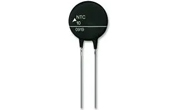NTC thermistors: Enhance BMS with precise temp control
Negative Temperature Coefficient (NTC) thermistors play a crucial role in Battery Management Systems (BMS) by providing accurate temperature monitoring.
This helps maintain safe operating conditions and offers precise thermal protection to prevent overheating. By ensuring reliable temperature readings, NTC thermistors safeguard the battery from potential damage, contributing to its longevity and overall system reliability. Their importance makes them essential components in modern power management systems.
Temperature monitoring & measurement
An NTC thermistor in a BMS primarily monitors the battery’s temperature during charge and discharge cycles. These thermistors are designed to decrease resistance as temperature increases, allowing them to detect and respond to temperature changes quickly. The BMS detects this voltage change, which can trigger protective actions, such as reducing the charging current, limiting the discharge rate, or even shutting down the battery pack if necessary.

Figure 1: Circuits in BMS for temperature sensing and compensation (Source)
Innovative charging circuits, especially lithium-ion batteries exposed to fluctuating temperatures, depend on NTC thermistors to detect ambient conditions and ensure safe charging. These thermistors provide precise temperature measurements, crucial for quick charging, as most batteries have specific temperatures (e.g., 0°C to 45°C). Continuous temperature monitoring during charging and discharging helps prevent overheating and optimises battery performance by providing accurate voltage measurements and charge estimation.
The core components of a BMS include the Cell Management Controller (CMC) and the Battery Management Controller (BMC). CMCs use multichannel ICs to monitor critical parameters such as temperature, impedance, voltage, and current, while the BMC coordinates the function of the individual CMCs. NTC thermistors are strategically placed near cells to detect hot spots. The thermistor’s resistance decreases as temperature rises, allowing the IC's analog-to-digital converter (ADC) to capture precise temperature readings. Accurate temperature data is crucial for maintaining battery health and ensuring the safety of the entire system.

Figure 2: Temperature detection for battery packs using NTC (Source)
Thermal protection
Modern batteries are designed to provide high current while maintaining a constant voltage. However, this can sometimes lead to over-temperature hazards, such as thermal runaway, resulting from overcurrent, overvoltage, or high ambient temperatures, leading to battery fires or explosions. To prevent such disasters, it is essential to monitor and avoid exceeding the upper safe temperature limits, which vary by Li-ion battery chemistry: 130-150°C for lithium cobalt oxide (consumer electronics), 170-180°C for lithium nickel manganese cobalt oxide (vehicles), and 250°C for lithium-ion manganese oxide (battery-powered tools). A complete shutdown of charging is crucial to avert potential disasters. In this context, NTC thermistors play a vital role in preventing thermal runaway—a phenomenon where an increase in temperature triggers further temperature rises, potentially resulting in battery failure or fire. NTC thermistors help prevent overheating during charging or discharging cycles, reducing the risk of thermal runaway.
In BMS, thermistors are commonly used in voltage divider configurations. These thermistors are connected to an ADC input of the BMS IC, which utilises the temperature readings to manage the battery effectively. As shown in Figure 3, thermal management can be effectively implemented by actively monitoring the battery cells through an analog-to-digital converter (ADC) or by utilising the thermistor output to compare against a reference voltage. This setup provides for overtemperature (OT) and under-temperature (UT) protection, ensuring the safety and reliability of the battery system.

Figure 3: Implementation of a NTC thermistor as a temperature monitor and switch (Source)
Efficient and precise temperature detection with thermistors
Thermistors offer an easy and effective solution for precise temperature detection. Their simple circuits, seamless integration, and reliable performance make them popular in various electronic applications.
Thermistors produce significant voltage changes over a wide temperature range, which can be directly connected to a microcontroller's analog-to-digital (A/D) port. This enables straightforward A/D conversion, with the microcontroller interpreting the voltage changes as temperature data. For example, programming the microcontroller to issue a warning at a specific temperature is simple by detecting the corresponding A/D-converted value. Unlike many other sensors, thermistors do not require an amplifier, as their voltage change is substantial enough for direct processing.
Assuming the thermistor voltage matches the A/D converter's input range of 0 to 3V, a 10-bit A/D converter provides a quantization unit of about 3mV. This translates to a temperature resolution of approximately 0.3°C across the full range of -20 to +85°C. Near room temperature, the resolution improves to less than 0.1°C due to a gain of over 30mV/°C. This simplicity makes thermistors an ideal choice for temperature detection in electronic devices.

Figure 4: Temperature detection circuit that uses a thermistor
When used with resistors, thermistors offer a practical and budget-friendly approach to temperature monitoring in electronic devices. While they may not achieve the highest precision, their cost-effectiveness and simplicity make them a viable choice. As shown in Figure 5, even with a resistance tolerance of ±1%, the voltage-temperature characteristics remain within a tight range. The bold line represents the central value, with the upper and lower limits indicated by the thin lines.
Further analysis in Figure 5 reveals potential errors of approximately ±1.5°C at +85°C and ±1°C at +60°C. Although these errors are not negligible, they are often acceptable for monitoring temperatures in electronic devices. The affordability and straightforward implementation usually outweigh the minor limitations in accuracy, making them a practical solution for many temperature-sensing applications.

Figure 5: The relationship between the divided voltage and the temperature of the thermistor
Conclusion
NTC thermistors are vital in BMS, ensuring accurate and reliable temperature monitoring to prevent overheating, thermal runaway, and battery damage. Their quick response to temperature changes and ability to trigger protective actions are vital to maintaining battery safety. NTC thermistors are also easy to integrate into BMS circuits and are cost-effective, making them an ideal choice for increasing battery safety and longevity across various applications. As battery technology advances, NTC thermistors will continue to play a vital role in enhancing thermal management and protection, contributing to the reliability and efficiency of modern power management systems.
Farnell, a global distributor, offers a wide range of thermistors to meet diverse energy needs and ensure high performance.
Stay informed
Keep up to date on the latest information and exclusive offers!
Subscribe now
Thanks for subscribing
Well done! You are now part of an elite group who receive the latest info on products, technologies and applications straight to your inbox.














